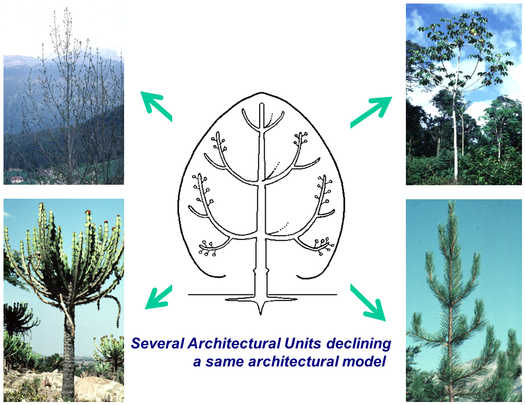Preliminary Course
Botany. Architectural Analysis
Architectural unit
The architectural model concept is too large and synthetic to be pragmatically useful in the field to approach species specificity.
Architectural Model limitations
-
Focusing architectural analyses on particular traits on each type of axis elaborated during plant development
usually leads to the stem (trunk) being distinguished from other axes, such that each set of axes exhibits
specific features (on young trees).
- Trunk (main stem) growth: rhythmic or continuous, determinate or not
- Main stem branching: none, diffuse, continuous or rhythmic
- Branches growth: determinate or not, orthotropic or plagiotropic
- Flowering position: terminal or lateral

Expressions of Rauh's model (Drawing and Photos D. Barthélémy, CIRAD)
Top left to right: Fraxinus sp, Cecropia sciadophylla
Bottom left to right: Euphorbia sp, Pinus sp.
Why is the Architectural Model ambiguous?
-
Architectural Model definition simplifies the axis typology.
Considering the 23 models, the underlying combination is quite reduced and can be defined as follow:
Moreover, the sets of branches are considered without distinction. The Architectural Model is thus not exhaustive as regards the various axis categories.
Instantiating the Architecture Model on a given species thus means:
1. Defining the set of morphological patterns for each category of identifiable axes, with the same precision
2. Completing the information by qualitative and quantitative morphological data (number of phytomers per growth unit, phyllotaxis value, etc.).
